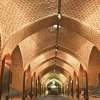About Zilu Museum of Meybod
The building of the Zilu Museum is located inside the Shah Abbasi caravanserai in Meybod. This caravanserai is just beside of the Sharestan section of the old town of Meybod which dates back to Savafid era. It is built in a form of four iwans with a large courtyard, a camel barn, a vestibule, and several halls.
.jpg)
The Zilu Museum of Meybod is a special museum for Zilu and other hand-woven rugs and carpets. This museum was founded by artistic people of Meybod in order to preserve and keep this valuable art alive. The background color of the Zilus are red, blue, white and green which is originated from ninth century AH. In this museum, there are some active looms for weaving, some work-shops in which some old people are weaving the Zilu and explaining the procedure at the same time.
.jpg)
Treasures of the Zilu Museum of Meybod
Historical Zilus in this museum have been gathered and accumulated by the efforts of Cultural Heritage, Handicrafts and Tourism Organization of Yazd province. There are 55 sample zilus in this museum which are really precious and valuable and the oldest of which belongs to Jame Mosque of Meybod and dates back to 808 AH (around 615 years ago). The Zilu Museum of Meybod includes 2 sections: old and new Zilu branches. Meybod is famous for the art of Zilu weaving which has been registered as an intangible heritage in the National Iranian Monuments List.
.jpg)
What Is Zilu?
Zilu is one of the oldest handwoven carpets by Iranians. cotton yarn is the main used in Zilu and although it seems so simple in primer texture, it is relatively advanced and full of special techniques. Zilu weaving in design and texture is much like weaving the wooden mat. Contrary to other types of carpets which often flourish in cold and nomadic environments, Zilu has been most common in rural and urban regions, especially in warm and dry areas.
.jpg)
Zilu weaving was also done in other provinces such as Fars, Khorasan, Azerbaijan and desert regions including Yazd many years ago. However, the most of the best Zilus were made in Meybod and sent to different parts of the country. In the past, Zilu was used in public places like mosques, shrines, and schools as well as home-use. Zilu is still used in some of these historic places.
.jpg)
For more information on the Zilu Museum of Meybod, please contact Raadina Support.
Online Support














.jpg)
.jpg)
.jpg)
.jpg)
.jpg)
